Nothing says summer more than an armload of cheerful zinnias. Available in a brilliant rainbow of colors, these happy blooms are a must-grow for any flower lover.
As one of the easiest cut flowers to cultivate, they are a perfect first crop for beginning growers and are reliable, prolific producers for most flower farms and gardeners.
We’ve been growing zinnias since the beginning, and every year I fall more and more in love with them.
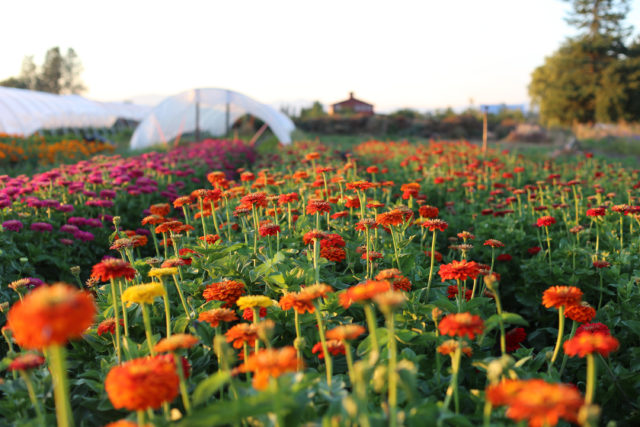 Zinnias resent cold weather and prefer to be planted after things have warmed up a bit. Many gardeners in warmer parts of the world are able to successfully direct-seed their zinnias straight into the field, but here in cool Washington we start seeds in 72-cell trays in the greenhouse 4 to 6 weeks before our last spring frost.
Zinnias resent cold weather and prefer to be planted after things have warmed up a bit. Many gardeners in warmer parts of the world are able to successfully direct-seed their zinnias straight into the field, but here in cool Washington we start seeds in 72-cell trays in the greenhouse 4 to 6 weeks before our last spring frost.
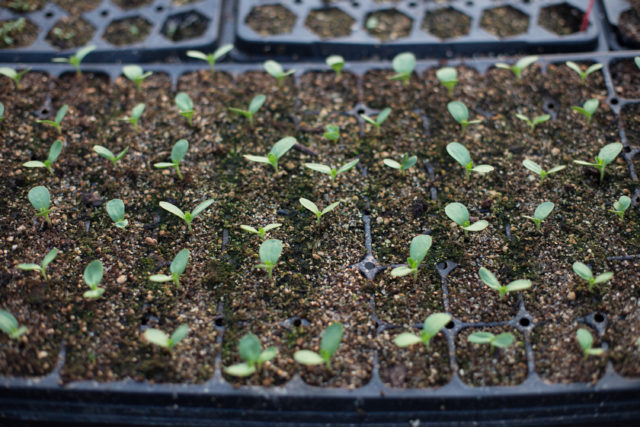 Plants are tucked into the field around mid-May, once the weather has sufficiently warmed up and all danger of frost has passed. Like every flower grown on our farm, we try to give them the best start possible. Learn more about soil preparation here.
Plants are tucked into the field around mid-May, once the weather has sufficiently warmed up and all danger of frost has passed. Like every flower grown on our farm, we try to give them the best start possible. Learn more about soil preparation here.
Once the planting beds have been prepared, we lay down four lines of drip irrigation, roughly 1 ft (30 cm) apart, and then the beds are covered with a layer of preburned landscape fabric to control weeds. Plants are spaced 9 in (23 cm) apart with 5 rows per bed.
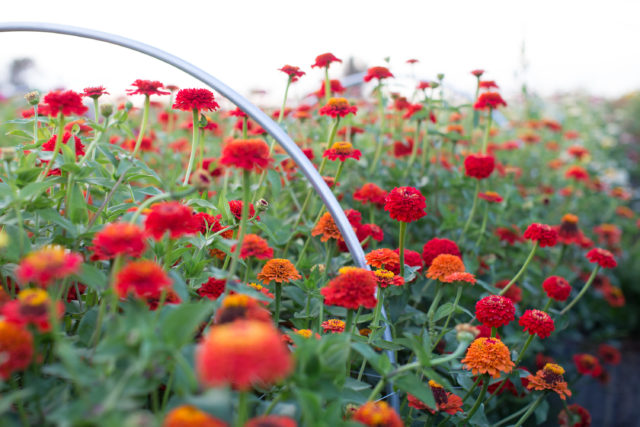 If given good soil and a steady supply of water, plants can get huge and require some type of support. We use a layer of Hortonova netting stretched horizontally about 12 in (30 cm) above the ground. Netting is held in place by metal hoops that we made with our Johnny’s Quick Hoops Bender. Any type of stake, wooden or metal, will work just fine. As the plants grow, they push up through the grid of netting and get the support they need.
If given good soil and a steady supply of water, plants can get huge and require some type of support. We use a layer of Hortonova netting stretched horizontally about 12 in (30 cm) above the ground. Netting is held in place by metal hoops that we made with our Johnny’s Quick Hoops Bender. Any type of stake, wooden or metal, will work just fine. As the plants grow, they push up through the grid of netting and get the support they need.
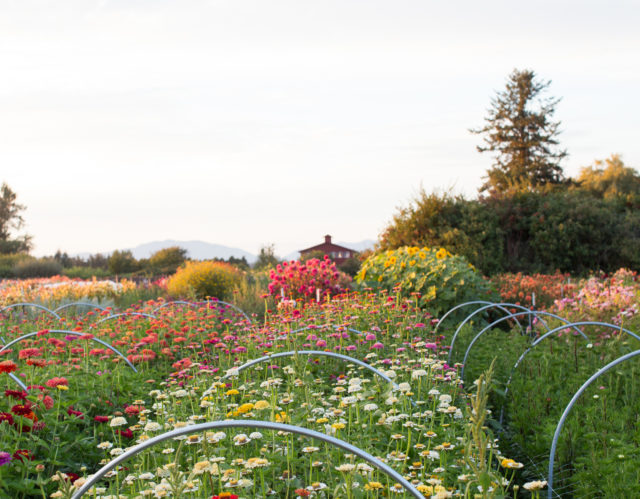 Zinnias like the heat, and it’s important that they are grown in full sun. In addition to choosing a sunny spot, I always grow them in fabric for the added heat.
Zinnias like the heat, and it’s important that they are grown in full sun. In addition to choosing a sunny spot, I always grow them in fabric for the added heat.
When we first started growing zinnias this closely together I was worried that they would be plagued by disease, but since they are grown in such rich soil, this hasn’t been a problem. We succession-sow zinnias every 2 to 3 weeks in order to have a steady stream of these beautiful blooms all summer long.
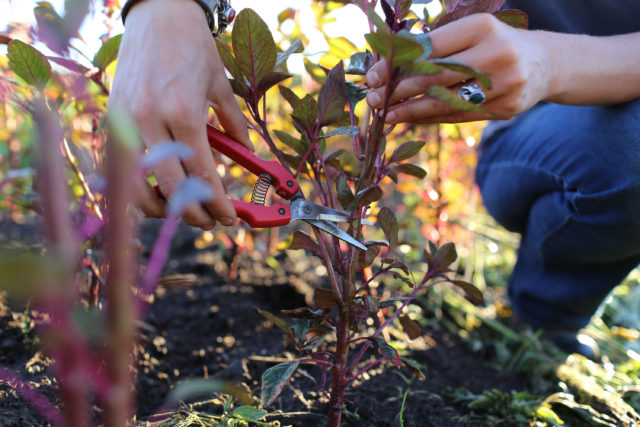 The secret to getting the longest stems from your zinnias is pinching them when they are young. Here’s how it’s done: When plants are between 8 to 12 in (20 to 30 cm) tall, take sharp pruners and snip the top 3 to 4 in (8 to 10 cm) off the plant, just above a set of leaves. This signals the plant to send up multiple stems from below where the cut was made, resulting in more abundant flower production as well as longer stem length. The photo above demonstrates pinching with another type of plant.
The secret to getting the longest stems from your zinnias is pinching them when they are young. Here’s how it’s done: When plants are between 8 to 12 in (20 to 30 cm) tall, take sharp pruners and snip the top 3 to 4 in (8 to 10 cm) off the plant, just above a set of leaves. This signals the plant to send up multiple stems from below where the cut was made, resulting in more abundant flower production as well as longer stem length. The photo above demonstrates pinching with another type of plant.
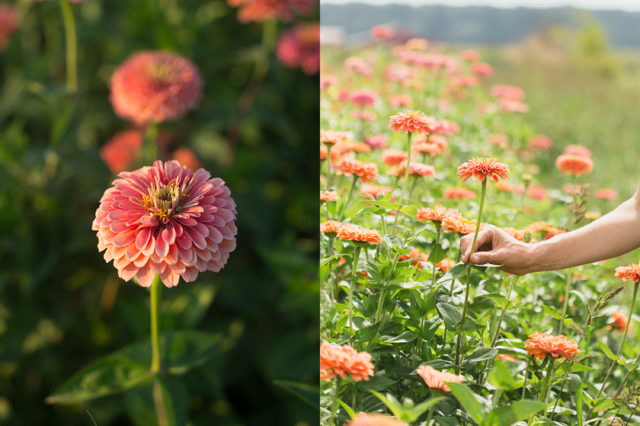 If you are not regularly harvesting your zinnias, be sure to deadhead any spent blooms to help focus the plant’s energy into producing new flowers and not going to seed.
If you are not regularly harvesting your zinnias, be sure to deadhead any spent blooms to help focus the plant’s energy into producing new flowers and not going to seed.
Zinnias need to be picked when they are fully ripe; otherwise, they won’t last in the vase. To tell whether a zinnia is ready to harvest, use the “wiggle test.” Simply grab the stem about 8 in (20 cm) down from the flower head and gently shake it. If the stem is droopy or bends, it is not ready to cut. If the stem is stiff and remains erect, it is ready to harvest.
Zinnias are considered a “dirty” flower and benefit from a drop or two of bleach in their water. Do not put them in the cooler since the flowers are very cold sensitive.
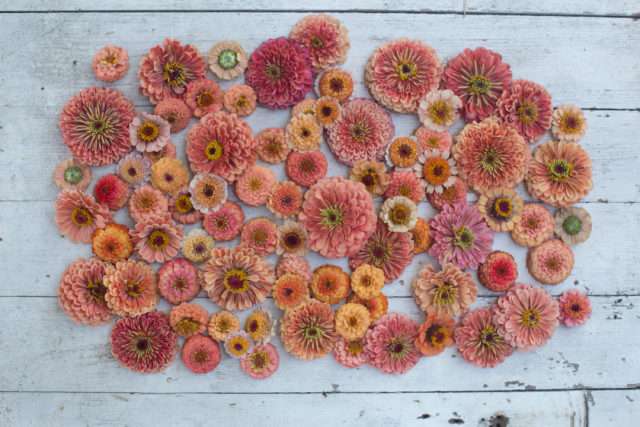 There are an unbelievable number of zinnias to choose from, in every shape, color, and size imaginable. No matter what your needs are, there is definitely a zinnia for you.
There are an unbelievable number of zinnias to choose from, in every shape, color, and size imaginable. No matter what your needs are, there is definitely a zinnia for you.
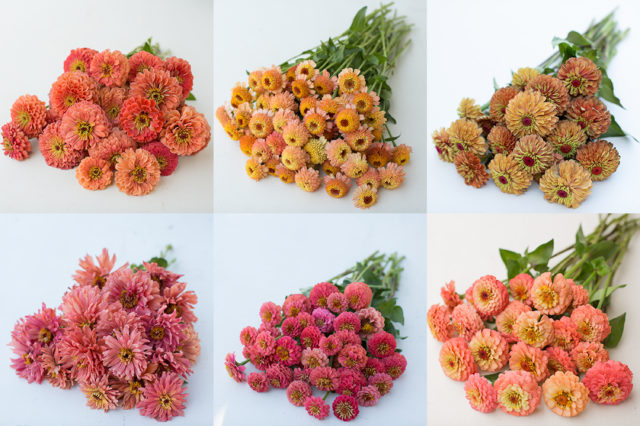 For example, if you’re looking for flowers in the peach-salmon range, look at how many choices there are!
For example, if you’re looking for flowers in the peach-salmon range, look at how many choices there are!
Top row, left to right: ‘Giant Salmon Rose’, ‘Zinderella Peach’, ‘Queen Lime Orange’.
Bottom row, left to right: ‘Señora’, ‘Lilliput Salmon’, ‘Oklahoma Salmon’.
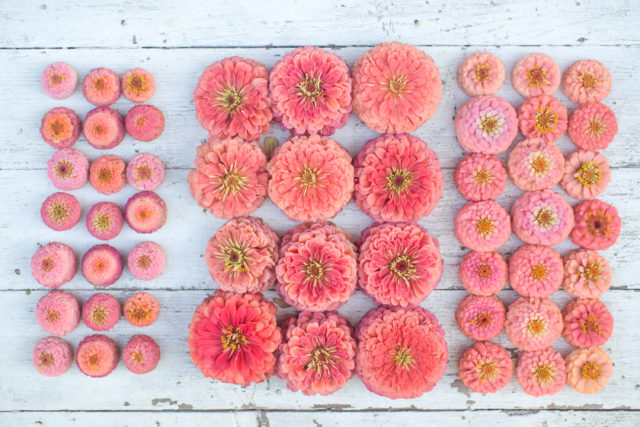 Here’s a great example of the different size options available in one color.
Here’s a great example of the different size options available in one color.
Left to right, above: ‘Lilliput Salmon’, ‘Giant Salmon Rose’, ‘Oklahoma Salmon’.
Left to right, below: ‘Giant Salmon Rose’, ‘Oklahoma Salmon’, ‘Lilliput Salmon’. 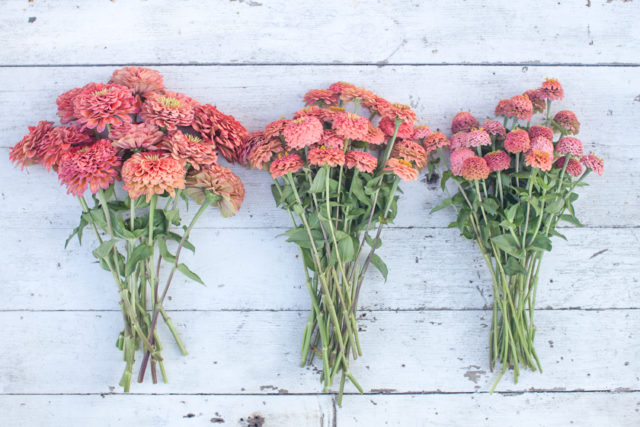 I thought I’d share some of my favorite varieties that we grow here on the farm in hopes that it inspires you to plant some of these hardworking, heat-loving beauties in your garden this season.
I thought I’d share some of my favorite varieties that we grow here on the farm in hopes that it inspires you to plant some of these hardworking, heat-loving beauties in your garden this season.

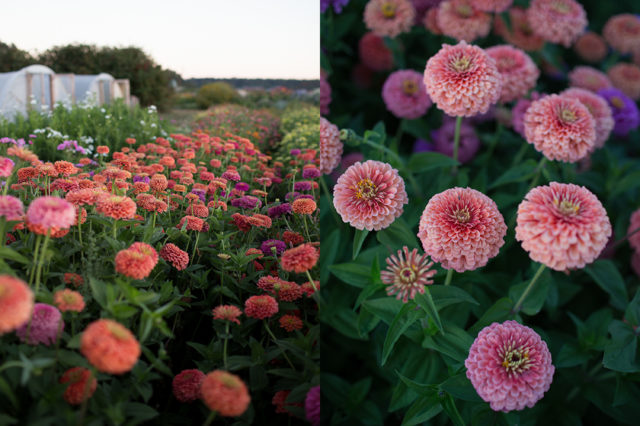 Benary’s Giant Series
Benary’s Giant Series
The largest-flowered varieties in the zinnia family, plants often reach 4 to 5 ft (1.2 to 1.5 m) tall and have a high percentage of huge double flowers. They come in a wide range of colors (13 total) and are known for their strong stems and good disease resistance.
My all-time favorite variety is ‘Giant Salmon Rose’ (pictured above) because its warm peachy color is so versatile and softens with age. It pairs well with both pastel and vibrant colors.
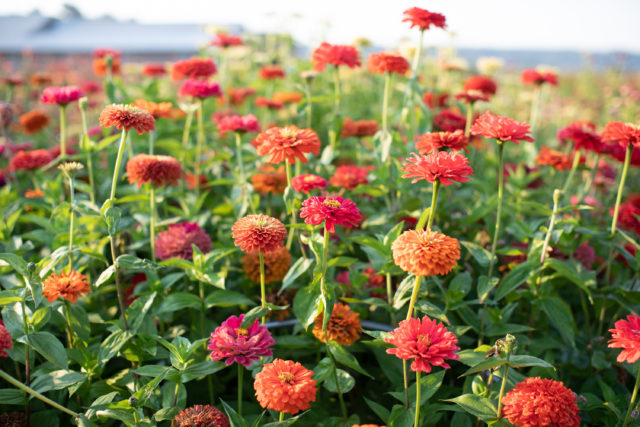 I also love the Desert Sunset Mix (pictured above), which includes my favorite warm-toned Benary’s Giant colors: ‘Giant Coral’, ‘Giant Orange’, and ‘Giant Carmine’. They make a bold statement when combined with acid-green or deep maroon flowers and foliage.
I also love the Desert Sunset Mix (pictured above), which includes my favorite warm-toned Benary’s Giant colors: ‘Giant Coral’, ‘Giant Orange’, and ‘Giant Carmine’. They make a bold statement when combined with acid-green or deep maroon flowers and foliage.
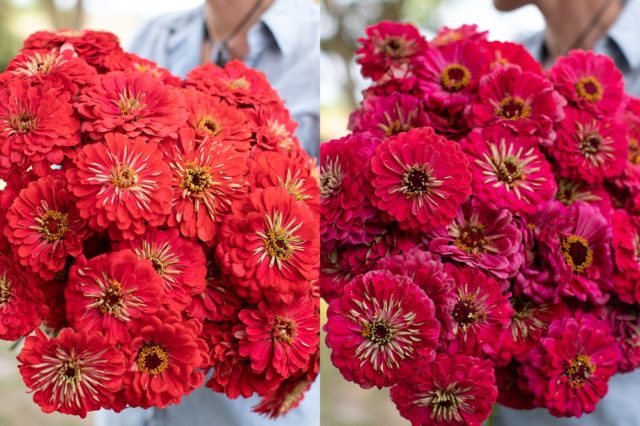 The individual colors in this series are stunning, especially en masse.
The individual colors in this series are stunning, especially en masse.
‘Benary’s Giant Coral’ (pictured above, left) is a glowing, tropical coral-salmon variety and a long-standing customer favorite. ‘Benary’s Giant Carmine’ (pictured above, right) has raspberry-pink blooms; as they age, the outer tips of the petals fade, giving blooms a multidimensional quality.
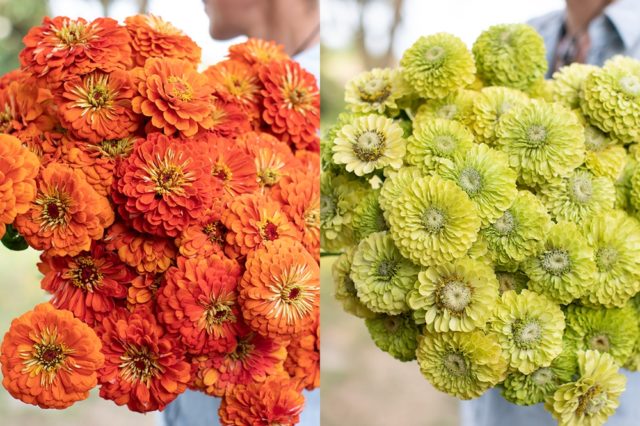 The petal tips of ‘Benary’s Giant Orange’ (pictured above, left) are edged with the tiniest hint of lavender, giving them an iridescent quality. The blooms of ‘Benary’s Giant Lime’ (pictured above, right) are a unique, Granny Smith apple green and deeply packed with petals.
The petal tips of ‘Benary’s Giant Orange’ (pictured above, left) are edged with the tiniest hint of lavender, giving them an iridescent quality. The blooms of ‘Benary’s Giant Lime’ (pictured above, right) are a unique, Granny Smith apple green and deeply packed with petals.
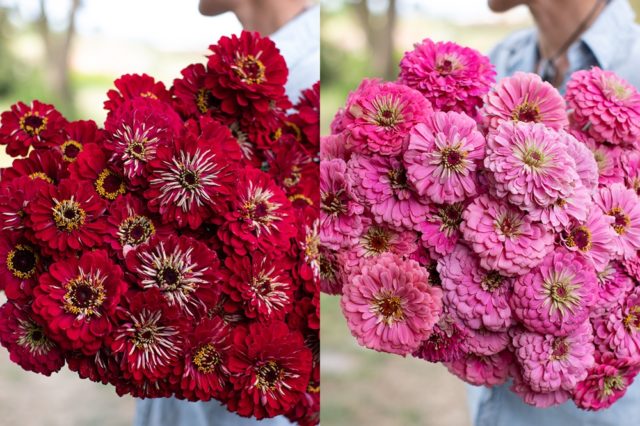 ‘Benary’s Giant Deep Red’ (pictured above, left) is a rich ruby red; the backs of the petals have the slightest hint of purple, giving them a glowing, iridescent quality. The cotton candy-pink blooms of ‘Benary’s Giant Bright Pink’ (pictured above, right) are as sweet as can be.
‘Benary’s Giant Deep Red’ (pictured above, left) is a rich ruby red; the backs of the petals have the slightest hint of purple, giving them a glowing, iridescent quality. The cotton candy-pink blooms of ‘Benary’s Giant Bright Pink’ (pictured above, right) are as sweet as can be.
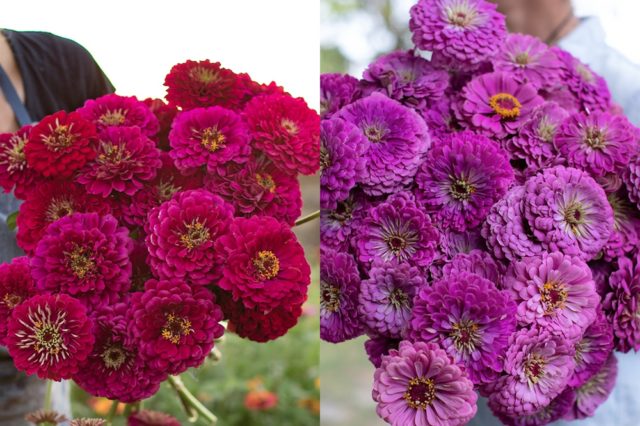 A customer favorite, ‘Benary’s Giant Wine’ (pictured above, left) is a dramatic, deep wine hue. ‘Benary’s Giant Lilac’ (pictured above, right) starts out a vivid lilac, and with time the outer petals fade to a cool pale lavender, giving it a haunting effect.
A customer favorite, ‘Benary’s Giant Wine’ (pictured above, left) is a dramatic, deep wine hue. ‘Benary’s Giant Lilac’ (pictured above, right) starts out a vivid lilac, and with time the outer petals fade to a cool pale lavender, giving it a haunting effect.
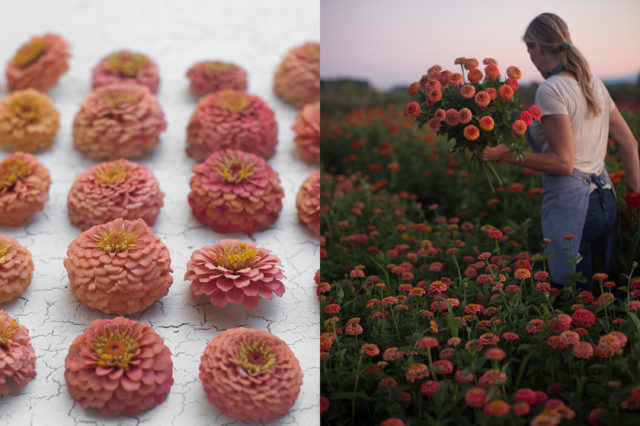 Oklahoma Series
Oklahoma Series
These are hands down the most productive and floriferous zinnias I’ve ever grown. The series boasts 7 colors, including ‘Oklahoma Salmon’, ‘Oklahoma Pink’, ‘Oklahoma Carmine’, ‘Oklahoma Ivory’, ‘Oklahoma White’, ‘Oklahoma Golden Yellow’, and ‘Oklahoma Scarlet’.
‘Oklahoma Salmon’ (pictured above) has petite, double blooms that are a warm mix of salmon and peach and combine well with anything. Everyone loves this treasure!
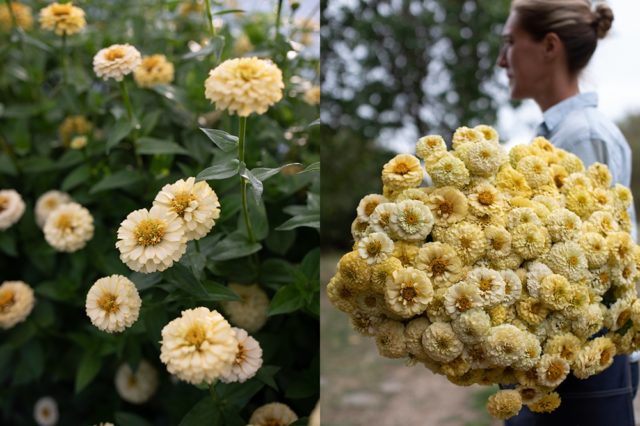 ‘Oklahoma Ivory’ (pictured above) had been discontinued but, to the delight of countless growers and designers, was brought back by Frank Morton at Wild Garden Seed here in the Pacific Northwest. We are so pleased to offer this variety, treasured for its versatile creamy ivory color and pretty double blooms.
‘Oklahoma Ivory’ (pictured above) had been discontinued but, to the delight of countless growers and designers, was brought back by Frank Morton at Wild Garden Seed here in the Pacific Northwest. We are so pleased to offer this variety, treasured for its versatile creamy ivory color and pretty double blooms.
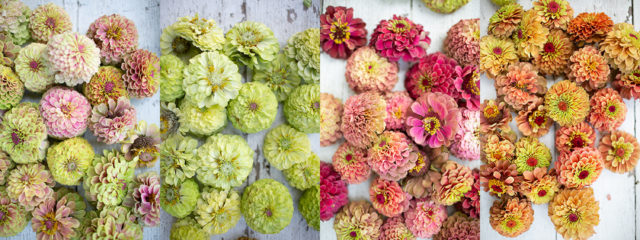 Queen Series
Queen Series
Unlike other zinnias, this series includes the most unique array of unusual coloring, including lime green, smoky apricot, dusty rose, and limey blush.
In addition to their special coloring, the Queen Series produces vigorous plants with sturdy stems and tough flowers, a welcomed improvement to the zinnia family.
These gorgeous novelties are sought out by designers for their unique coloring.
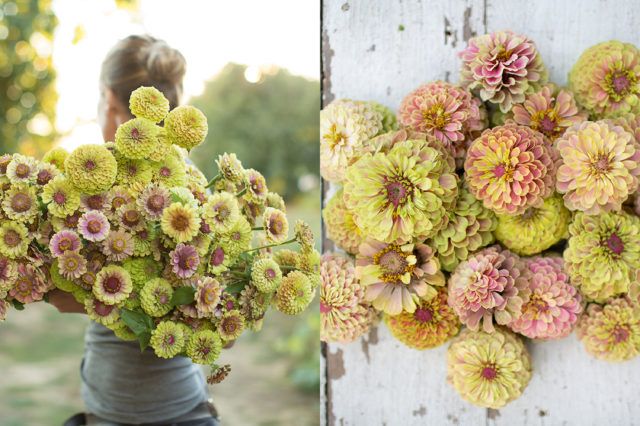 The mostly double and semi-double flowers of ‘Queen Lime Blush’ (pictured above) are a stunning blend of green and purple, unlike anything we’ve seen. Everyone who sees them instantly falls in love. It’s a must-grow!
The mostly double and semi-double flowers of ‘Queen Lime Blush’ (pictured above) are a stunning blend of green and purple, unlike anything we’ve seen. Everyone who sees them instantly falls in love. It’s a must-grow!
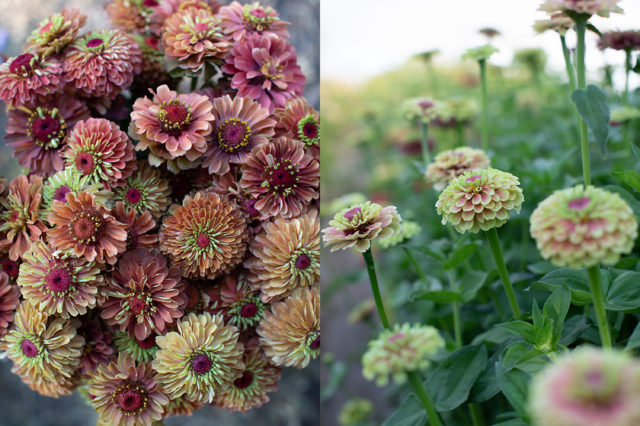 ‘Queen Lime Orange’: This exciting new addition to the Queen Series is the most beautiful range of iridescent raspberry, apricot, and smoky peach, with a dark cranberry center. This versatile color looks incredible when combined with rich foliage and blooms.
‘Queen Lime Orange’: This exciting new addition to the Queen Series is the most beautiful range of iridescent raspberry, apricot, and smoky peach, with a dark cranberry center. This versatile color looks incredible when combined with rich foliage and blooms.
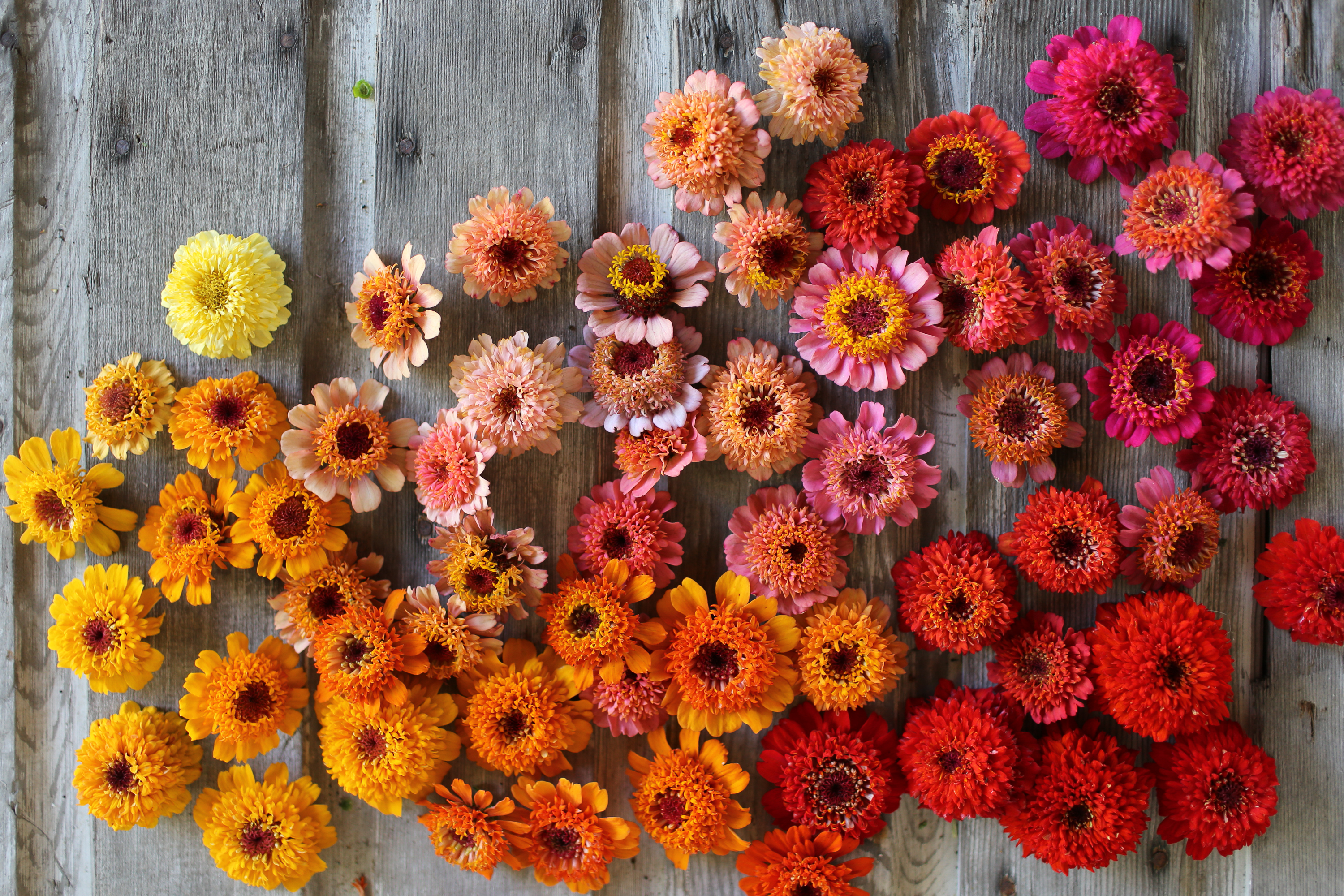
Scabiosa-flowered types
I grew scabiosa-flowered zinnias for the first time in 2014, and they quickly became one of my favorite crops of the season. The frilly double blooms look like mini gerbera daisies or double-flowered echinacea.
They have nice long stems and good disease resistance, and they come in a beautiful range of colors.
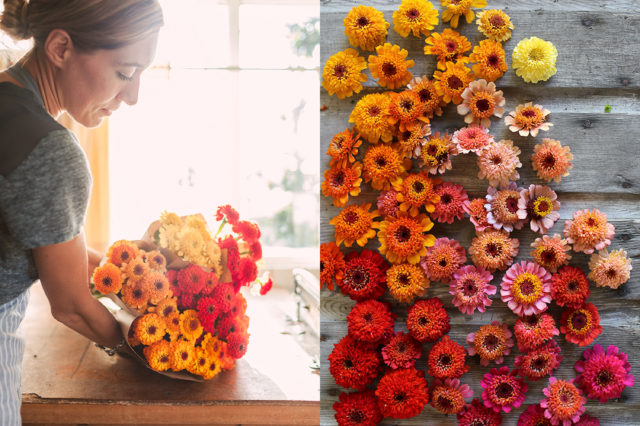 Candy Mix (pictured above) is an improved mix that contains a higher percentage of double flowers in a warm, cheerful blend of scarlet, raspberry, rose, salmon, tangerine, gold, and cream.
Candy Mix (pictured above) is an improved mix that contains a higher percentage of double flowers in a warm, cheerful blend of scarlet, raspberry, rose, salmon, tangerine, gold, and cream.
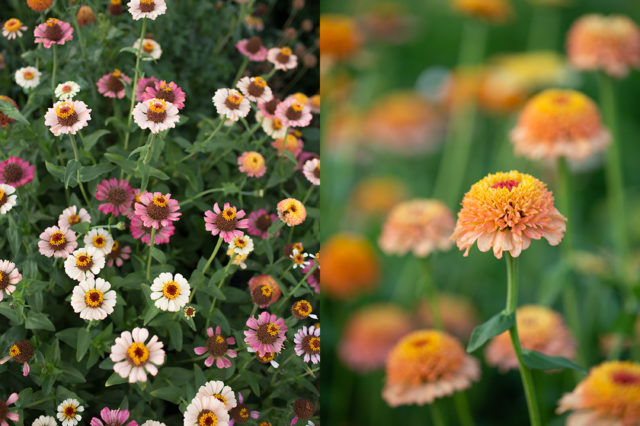 One point to note is that many growers in warmer climates have noticed that they don’t get the same high percentage of doubles with scabiosa types (doubles pictured above, right) that we do here in the Northwest.
One point to note is that many growers in warmer climates have noticed that they don’t get the same high percentage of doubles with scabiosa types (doubles pictured above, right) that we do here in the Northwest.
After a lot of research and emails back and forth with the breeders, I believe that if plants undergo any stress, including not getting enough water or too-high temperatures, they will start producing single flowers (pictured above, left).
While the single blooms are pretty and unique, many folks have been disappointed by this fact.
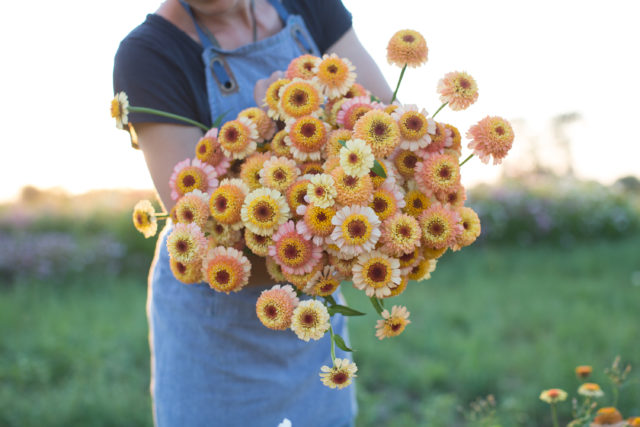 ‘Zinderella Peach’ (pictured above) has frilly double blooms that are a warm mix of salmon, peach, and cream, accented by a striking dark center. Of all the zinnias we grow, this might be my favorite.
‘Zinderella Peach’ (pictured above) has frilly double blooms that are a warm mix of salmon, peach, and cream, accented by a striking dark center. Of all the zinnias we grow, this might be my favorite.
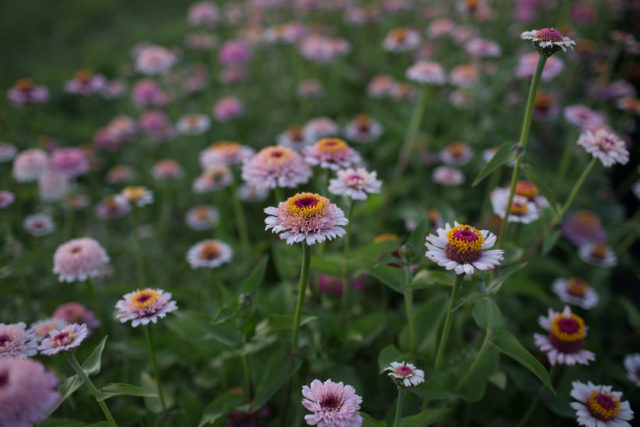
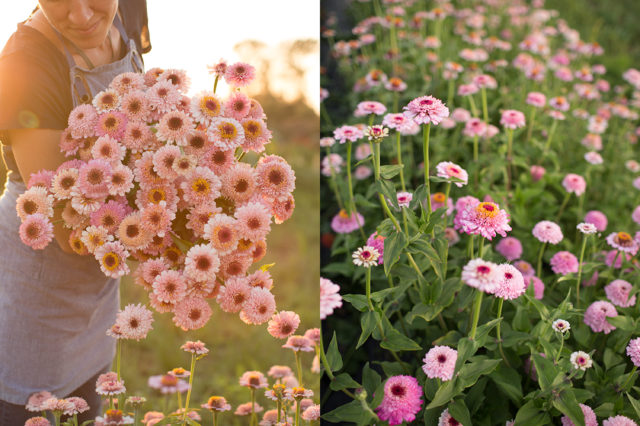 ‘Zinderella Lilac’ (pictured above) is a lovely mix of blush and soft lavender, accented by a striking dark center. It’s ideal for wedding work, and floral designers love it!
‘Zinderella Lilac’ (pictured above) is a lovely mix of blush and soft lavender, accented by a striking dark center. It’s ideal for wedding work, and floral designers love it!
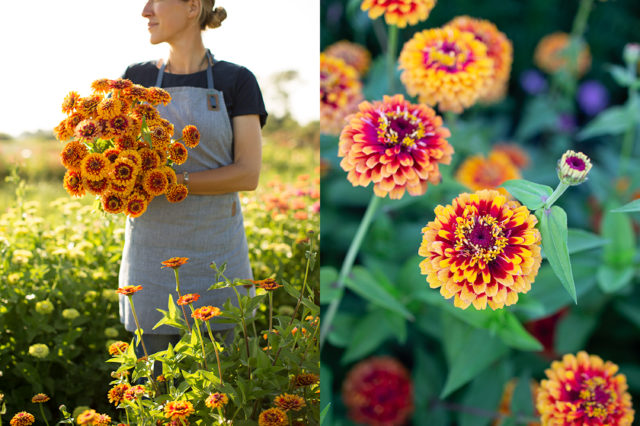 Bicolor novelties
Bicolor novelties
These unique bicolor novelties are sure to catch the attention of everyone who sees them.
We’ve been growing ‘Macarenia’ (pictured above) for years and have found that people either love it or hate it. Each glowing scarlet petal is tipped in gold for a fun twist. Winner of the Fleuroselect Novelty Award in 2012, this hardworking plant thrives in heat and is very easy to grow.
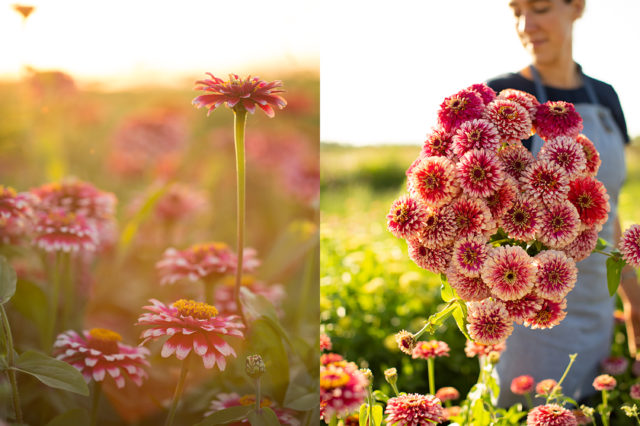 ‘Mazurkia’ brings a new twist to zinnias and is a Fleuroselect winner for good reason. The midsize plant produces fun, campy, double flowers with lipstick-pink centers and soft blush tips.
‘Mazurkia’ brings a new twist to zinnias and is a Fleuroselect winner for good reason. The midsize plant produces fun, campy, double flowers with lipstick-pink centers and soft blush tips.
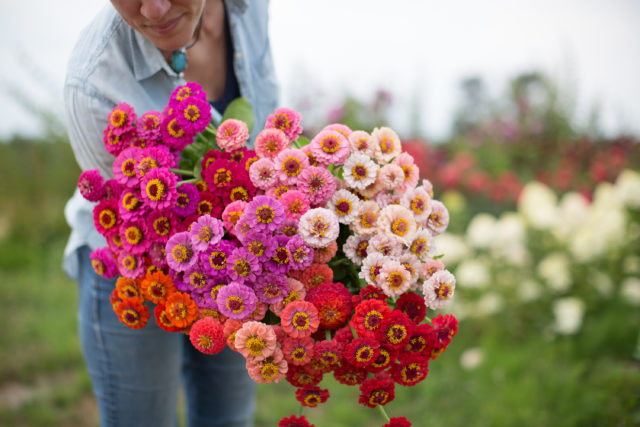 Miniature-flowered types
Miniature-flowered types
The old-fashioned Lilliput Mix (pictured above) deserves a spot in every cutting garden. The easy-to-grow, heat-loving plants produce a bumper crop of sweet blooms on long, strong stems in shades of rose, carmine, orange, coral, white, yellow, and violet. Their petite flower size makes them ideal for flower arranging.
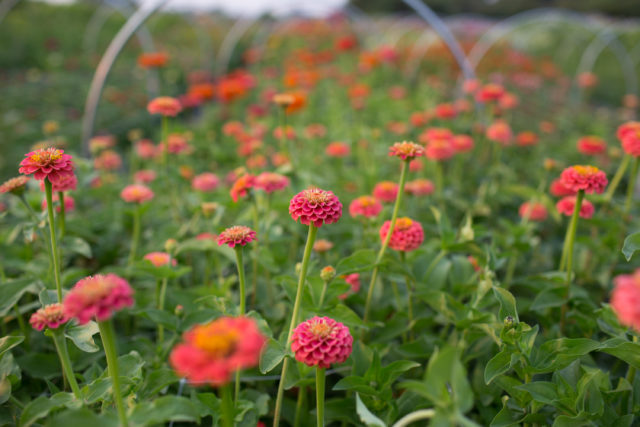 I especially love ‘Lilliput Salmon’ (pictured growing above). This adorable bloomer produces an abundance of petite, fully double, dome-shaped salmon flowers all summer long.
I especially love ‘Lilliput Salmon’ (pictured growing above). This adorable bloomer produces an abundance of petite, fully double, dome-shaped salmon flowers all summer long.
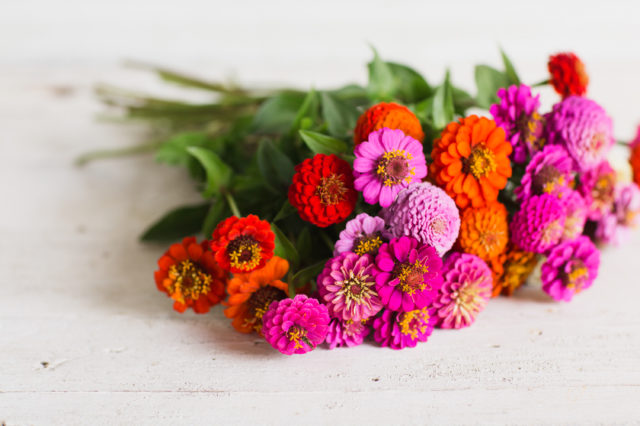 The Sunbow Series (pictured above), available from Johnny’s Selected Seeds, has been around for ages and has miniature 1- to 2-in (2.5- to 5-cm) double blooms that ride atop long, sturdy stems. It comes in a cheery mix including rose, purple, golden yellow, scarlet, orange, pink, and white. Plants have long, wiry stems that make them well suited to flower arranging.
The Sunbow Series (pictured above), available from Johnny’s Selected Seeds, has been around for ages and has miniature 1- to 2-in (2.5- to 5-cm) double blooms that ride atop long, sturdy stems. It comes in a cheery mix including rose, purple, golden yellow, scarlet, orange, pink, and white. Plants have long, wiry stems that make them well suited to flower arranging.
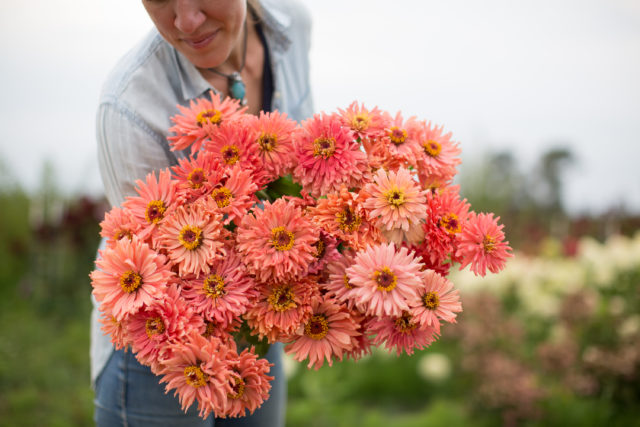 Cactus-flowered types
Cactus-flowered types
These fun novelties have the coolest twisted, shaggy petals and come in a wide range of colors, including orange, pink, red, yellow, peach, and white.
My favorite is ‘Señora’ (pictured above), which has warm salmon-apricot, quilled blooms and produces a bumper crop of large flowers that have long, strong stems. It’s a must-grow!

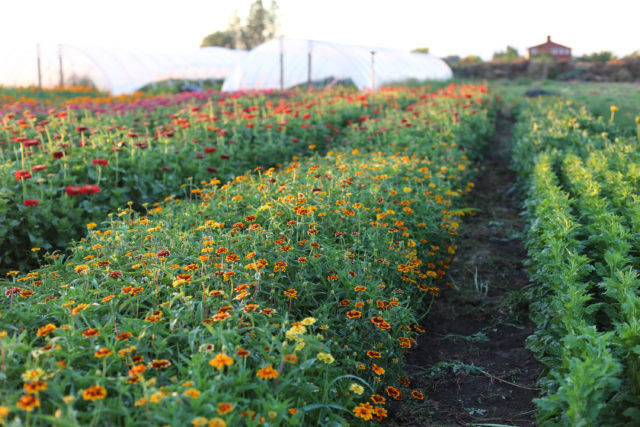 Mexican zinnias
Mexican zinnias
While plants themselves are compact, they churn out an abundance of stems for cutting from midsummer to early autumn. With their petite stature, they resemble a bedding plant more than a cropping variety, but I think they deserve a spot in every cutting garden.
The Persian Carpet Mix (pictured above) includes adorable gold, cranberry, orange, and cream flowers.
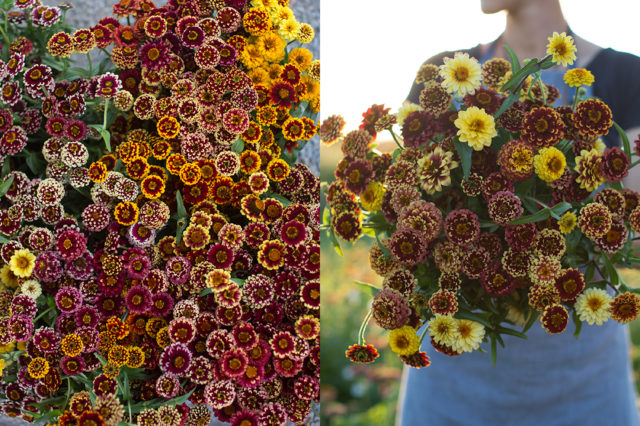 The brilliant, eye-catching Aztec Sunset Mix (pictured above) includes a wide range of miniature bicolor blooms in shades of buttercream, gold, cranberry, rust, and merlot. These reliable bloomers are a great addition to the cutting garden and the front of the flower border.
The brilliant, eye-catching Aztec Sunset Mix (pictured above) includes a wide range of miniature bicolor blooms in shades of buttercream, gold, cranberry, rust, and merlot. These reliable bloomers are a great addition to the cutting garden and the front of the flower border.
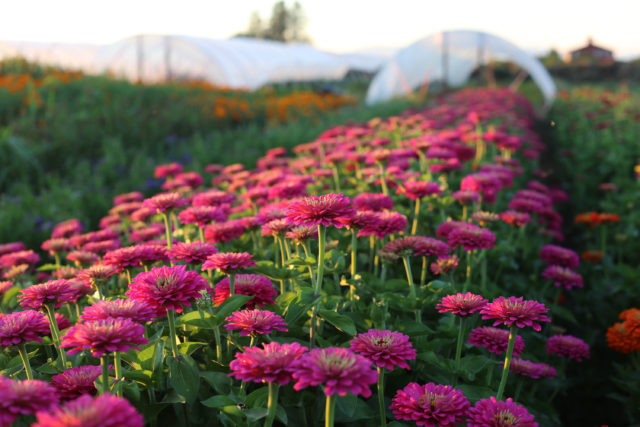
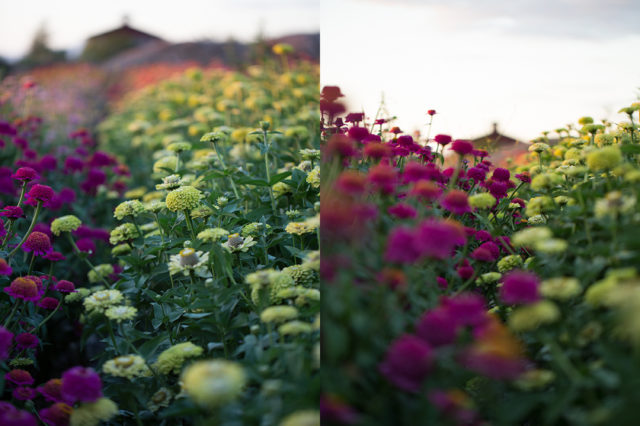 I would love to hear your experience with this wonderful group of plants. Do you grow zinnias or plan to add them to your garden this coming season? If so, what are your favorite varieties, or what new treasures are you adding to your wish list?
I would love to hear your experience with this wonderful group of plants. Do you grow zinnias or plan to add them to your garden this coming season? If so, what are your favorite varieties, or what new treasures are you adding to your wish list?
Please note: If your comment doesn’t show up right away, sit tight; we have a spam filter that requires us to approve comments before they are published.

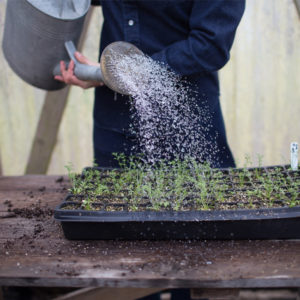

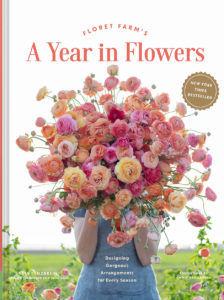



Michelle on
If you wait until they dome (absolutely love them like this), will they last a lesser amount of time in the vase?